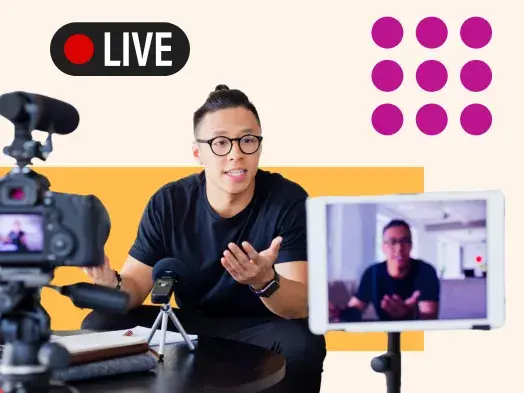Video is dominating social media marketing. In fact, experts predict video will account for 80% of global internet traffic by 2019. So now is the best time to master the medium.
Thanks to easy and free video creation tools, you don’t need a big budget, professional equipment, or a filmmaking degree to make compelling videos for your brand. But since each social network comes with its own guidelines and unique audiences, you'll need an understanding of what kind of content is effective on each network.
We’re breaking down what performs best on four of the top networks: Instagram, Facebook, Twitter, and YouTube, so you can easily create videos that truly shine no matter where you share them.
Creating Video for Your Instagram Newsfeed
Instagram has experienced incredible growth recently -- especially in terms of video options -- but let’s first talk about your main Instagram page.
These posts, which appear in your followers' feeds, are the main window into your business or brand. As such, you want to reserve this space for your most polished, on-brand content. Here you might publish a video that explains your brand’s value, or a process video that offers an inside peek into your craft.
Keep these Instagram video rules in mind when creating your video story:
Instagram imposes a one-minute time limit. If you have a longer piece of content that you still want to promote, you can post a portion as a teaser on Instagram and use the link in your bio to drive people to your website to see the whole thing. Note this in your caption and add a tracking code to the link so you know how it performs.
Keep it inside the box. Videos can play in square, vertical, or landscape mode, but make sure you tap the “expand” button in the bottom left corner if you have a non-square video so it does not appear cropped.
Video covers are important! Instagram allows you to select a video cover that shows as a thumbnail in the feed. Make sure you select an intriguing frame to compel people to watch.
The best videos work with sound off. Instagram videos autoplay with the sound off, so make sure your message is clear whether or not the viewer taps for sound.
The following examples from Persnickety Prints, a photo printing company, show how video can help communicate both your mission and craft, two essential pieces of content for small business video marketing.
A post shared by Persnickety Prints (@persnicketyprints) on
A post shared by Persnickety Prints (@persnicketyprints) on
You can also modify classic Instagram content pieces into video, like this slideshow video that transforms a #motivationmonday post:
A post shared by Adobe Spark (@adobespark) on
Creating Videos for Instagram Stories
Instagram’s new Snapchat-like feature is the latest platform to win marketers’ hearts and time. And for good reason. IG stories have impressive engagement stats: according to Instagram, one in five Stories earn a direct message from viewers and one-third of the most viewed Stories come from businesses.
Instagram Stories are cool because they’re fleeting inside looks that allow you to create more of a connection with your followers. Feel free to get a little less polished and little more real with on-the-fly content that use stickers, filters, and emojis. Here are the basic parameters to remember when creating your Instagram Stories videos.
Take the opportunity to get personal.Unlike posts to your Instagram page, Instagram Stories last for 24 hours and users see them by clicking on the avatars at the top of their feed. Live Video disappears once the broadcast is over.
You don't have to edit everything directly in Instagram. You can shoot photo or video within the app, but if you’d like to use graphics, animations, or video that you’ve created previously, simply swipe up in the Stories view to publish content from your camera roll.
Keep in mind, the only content available will be videos or photos created within the last 24 hours. Consider using a free graphic design tool, like Adobe Spark, which allows you to resize content for Instagram Storiesand animate text.
Keep it short and sweet. Each photo or video that you include in an Instagram Story is limited to 10 seconds. Live broadcasting from inside the app is limited to one hour.
Don't be afraid to share multiple stories a day. You can post as much as you’d like without fear of annoying your followers because users have to opt-in to see the content.
You can tag users within stories. Tag other Instagram users in your video by typing their handle using the text feature in the top right corner. Tagged users will have a notification sent to their Instagram inbox.
We suggest offering content to your followers they can’t get anywhere else across your channels. This provides incentive to follow you and can act as a great conversion tool for your most active supporters or customers. You might post about a special offer, provide a behind-the-scenes view of your business, or go live to talk directly to your followers, which doesn’t require anything special beyond guts and tapping the button.
Creating Video for Facebook
Facebook has 1.94 billion monthly users and they watch more than 100 million hours of video each day. Take for example Tasty -- Buzzfeed’s food video offshoot -- which is hitting 1.8 billion video views each month on the platform. Facebook rewards this video content like crazy in the algorithm, which means hopping on this macro trend will score you more visibility on the network.
Like Instagram, you can go live directly on the platform to talk to your users. However, live video is fleeting -- great for boosting engagement on your page, not so great for generating traffic back to your site or creating content that you can use over and over. For that, you still need polished video content that speaks to your value or tells a story.
There are three things to keep in mind when creating a video for Facebook:
Ask yourself: will my viewers watch this whole video? There’s no time limit, but the algorithm rewards content that viewers watch all the way through and generates interactions (likes, shares, and comments). The best videos capture attention within the first three seconds.
Your video should work with the sound off. Up to 85% of viewers watch their Facebook videos with no sound, according to media publication Digiday.
Videos that autoplay in the newsfeed garner 186% more engagement than videos shared via posted link. You can use the Adobe Spark Video iOS app to natively share on Facebook with one tap.
In a single month last year over 3 million small business owners posted a video to Facebook. Here's an attention-grabbing example made with Adobe Spark that conveys a story regardless of sound:
Creating Video for Twitter
Live video and curated video content are booming on this formerly text-driven platform. Twitter has well over 800 million monthly users, 82% of whom engage with brands on the platform, according to its Video Playbook report.
Video views on Twitter grew 220 times from what they were in 2016 to 2017, and opportunities for advertisers are also growing, with the site offering pre-roll ads for live video and replay for Periscope videos as of March 2017, according to Forbes Tech writer Kathleen Chaykowski. But you don’t necessarily need a large advertising budget to capitalize on this trend.
Create polished video content for your Twitter feed keeping these three rules in mind:
Max video length is currently 140 seconds for imported content.
Grab attention within the first 3 seconds to stop thumbs from scrolling.
Upload videos natively to Twitter to ensure autoplay in the newsfeed.
Whether you animate graphics or use video clips, you’ll engage your audience. Check out a few examples of these techniques in action:
What story will you tell? Join us for a intro to Adobe Spark this Tuesday at 12:30PM. https://t.co/g3q45uUxRj#tutorial#nptechpic.twitter.com/EtrNUU4WgT
-- TechSoup (@TechSoup) May 6, 2017
#MayTheFourthBeWithYou#StarWarsDaypic.twitter.com/lwjA08JDyA
-- Adobe Spark (@AdobeSpark) May 4, 2017
Creating Video for YouTube
Youtube has over 1 billion users who watch hundreds of millions of hours of YouTube per day. Unlike the other social platforms on this list, YouTube comes with Google’s massive search power and metadata tools, too.
Your content strategy for YouTube should support your overall SEO stratgey. One way to go about this is to figure out which keywords you want your brand to rank for and craft compelling and entertaining video content that uses those keywords in your video, titles, images, and video descriptions.
The key to is to think about what the ideal path for your customer is who is coming through Google search. Say your company is a photo printing company. You might be interesting to people who are searching for things such as “engagement photos” “scrapbooks” etc. If you want to capture those interested folks, your best bet is to create content for what they’re already searching for.
There are also certain types of videos that people eat up on the platform. According to marketing agency Mediakix, product reviews and how-to videos rank as the top two types of videos on YouTube, with vlogs (video blogs) coming in at number three.
This is great news for small businesses because the platform comes primed with a huge audience looking to learn more about products or how to do something. You could ask influencers or customers to post a video review of your business to marry your influencer marketing with your content strategy or you could create a series of how-to videos that relate to your product or service.
When crafting and publishing video content to Youtube, keep these tips in mind:
Short videos still rule the day, but long form content is gaining traction. if you’re just starting out on YouTube or have an unverified account, your videos will be limited to 15 minutes. However, once verified, you can surely publish your hour-long webinars, trainings, or courses and of all the social networks and YouTube is the best place for those content pieces.
Skip the long intro and instead jump right in with your hook to improve viewer retention.
Use YouTube’s built-in caption generator to create subtitles for dialogue.
Don’t neglect your metadata fields. Your title, description, keyword -- even channel art -- are all meta data that tell search engines how to index your content and make sure it surfaces in front of interested searchers. Craft keyword-rich titles and descriptions and use YouTube’s keyword fields to improve search ranking. Add your bio, tagline, and website link to the description field of every video you publish so it’s easy for viewers to learn more about you.
Add a YouTube channel art. Just as your video and metadata tell search engines that your content is relevant, your YouTube channel art and video thumbnailstell people browsing through search results that they should click and watch.
Your YouTube video cover and thumbnail are additional branding opportunities to communicate your content’s value and compel clicks. Plus, it makes your channel look more professional, which is important when competing on this massive platform.
Video Isn't Optional
The moral of the story? Your business belongs on video across all platforms. Regardless of the platform, there are three overarching points to keep in mind when creating your social video content:
1) The best videos grab attention within the first 3 seconds and inspire emotion in viewers.
2) Text on screen is a crucial ingredient to social video marketing,
3) A clear call-to-action is essential to seeing results.
Now go create something!
Video Marketing





![The best social media platforms for video content in 2025 [consumer data]](https://53.fs1.hubspotusercontent-na1.net/hubfs/53/img-1-20250516-9399498.webp)


![3 Short-Form Video Trends Marketers Should Watch in 2025 [New Data]](https://53.fs1.hubspotusercontent-na1.net/hubfs/53/ft-short-form-video-trends.webp)
![Are In-Stream Video Ads Worth the Investment? [Benefits & Best Practices for Marketers]](https://53.fs1.hubspotusercontent-na1.net/hubfs/53/in-stream-video-ads-1-20250314-6407067.webp)
![45 Video Marketing Statistics for 2025 [New Data]](https://53.fs1.hubspotusercontent-na1.net/hubfs/53/video-marketing-statistics-1-20250227-6425117.webp)
![Why You Should Leverage Interactive Videos [Data from 500+ Marketers]](https://53.fs1.hubspotusercontent-na1.net/hubfs/53/interactive-video-1-20250216-406926.webp)
![Silent But Mighty: How Soundless Videos Are Winning Social Media [+ 2025 Data]](https://53.fs1.hubspotusercontent-na1.net/hubfs/53/Soundless%20Videos%20We%20Love.png)